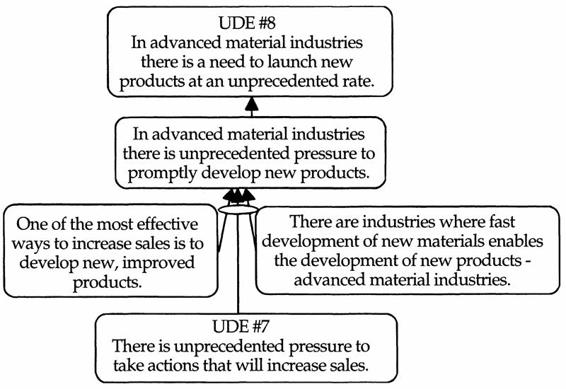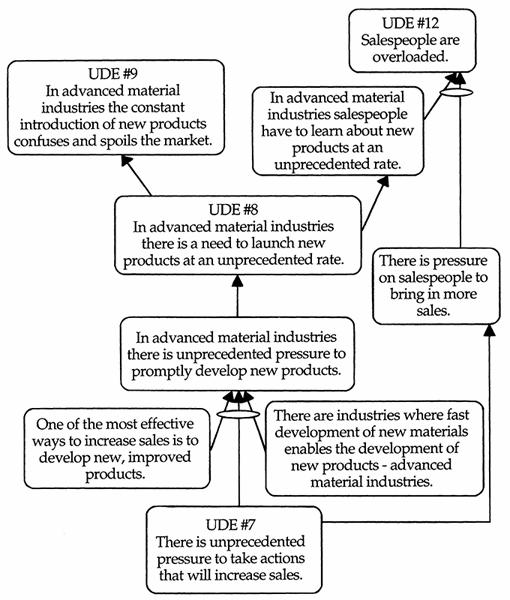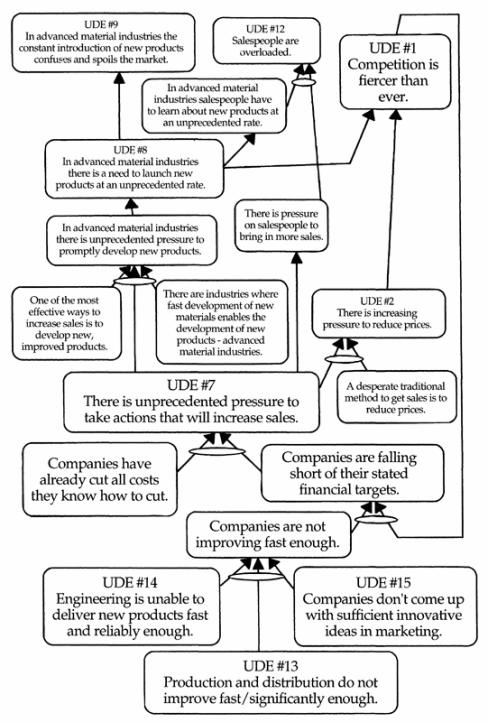It's Not Luck (16 page)
Authors: Eliyahu M. Goldratt

“It’s long, but it makes perfect sense.” Brandon is satisfied. “Let’s correct the top statement accordingly.”
Since I already know how clear his handwriting is, I prefer to do it myself. Now the upper statement reads, “In advanced material industries there is a need to launch new products at an unprecedented rate.”

“So far, it’s common sense, nothing more,” Doughty says.
I restrain myself from reminding him that just a few minutes ago we had a lot of reservations regarding this “common sense.”
“Common sense, my foot,” Brandon is less forgiving.
“If it were just common sense, how come I didn’t agree with the way we initially wrote the first arrow and it has taken us almost half an hour to reach this stage?”
“Okay, okay,” Jim apologizes, “I didn’t say that to construct common sense was easy. But Alex, what’s the next step? So far we have connected only two of the UDEs, we have thirteen more to go.”
“That is exactly the next step,” I say. “We have a solid nucleus, we have to connect all the other UDEs to it. But slowly, this process cannot be rushed. What other UDE can we easily connect?”
“The next one on the list,” Brandon says. “ ‘The constant introduction of new products confuses and spoils the market.’ ”
I check it. “If ‘In advanced material industries there is the need to launch new products at an unprecedented rate,’ then, ‘In advanced material industries the constant introduction of new products confuses and spoils the market.’ It fits.” I add it to the tree.
“What about UDE number twelve,” Jim suggests. “ ‘Salespeople are overloaded.’ It seems like we should be able to connect it pretty easily.”
Well, it wasn’t so easy. After several trials and errors we found out why. This UDE didn’t stem from one place in our tree but from a combination of two reasons. When we finally finished, it was connected in the following way: If “There is unprecedented pressure to take actions that will increase sales,” then, “There is pressure on salespeople to bring in more sales.” This by itself is not enough to justify an overload, but on top of it there is something else demanding their time. If “In advanced material industries there is unprecedented pressure to promptly develop new products,” then, “In advanced material industries salespeople have to learn about new products at an unprecedented rate.” Now we could put it together. Now it’s clear, why “In advanced material industries salespeople are overloaded.”
“And what about regular industries, industries where advanced materials don’t push them into the rapid race for new products?” I wonder aloud. “We cannot neglect them.”

“As I pointed out,” Brandon says, “even for these industries the starting point is still valid. They too are under unprecedented pressure to increase sales.”
“We know the immediate result of such a pressure,” Jim picks up the ball, “we know it too well. Let’s not forget that a desperate traditional ‘method’ to get an order is to reduce price. Alex, what should we do with it? I thought that we should concentrate only on connecting additional UDEs to our tree.”
“Yes, and there is no contradiction.” Two more post-its and I read the result: “If ‘There is unprecedented pressure to take actions that will increase sales,’ and ‘A desperate traditional method to get sales is to reduce prices,’ then, ‘There is increasing pressure to reduce prices.’ Hello UDE number two, welcome to the party.”
“And this UDE is, unfortunately, correct for almost every industry,” Brandon sighs.
“I think,” Jim is into it, “that we just reached UDE number one; ‘Competition is fiercer than ever.’ What fuels competition more than a price war? Put on top of it the technological war, the launching of new products at an unprecedented rate, and you get the real thing. That is what we see all around us, that’s it.”
I don’t hurry to add it to the tree. Brandon also looks skeptical. “What’s the matter?” Jim pushes us. “Don’t you think that pressure to reduce prices, especially when it is often enhanced by the rat race to introduce new products, is the cause for the fierce competition that we face everywhere?”
“Yes, we do,” Brandon reluctantly admits. “But . . . ”
“But what?”
“But, I thought that the fact that competition is fiercer than ever is the cause for the fact that ‘There is unprecedented pressure to take actions to increase sales.’ ”
“Yup, I see your point.” Jim turns to me. “What are we supposed to do now?”
“What’s the problem?” I pretend not to understand.
“The problem is,” Brandon explains to me patiently, “that according to Jim, UDE number one is the result of what we wrote, so it’s supposed to be at the top of the tree. But according to what I say, UDE number one is the cause of our starting point, and it should be at the very bottom of the tree.”
“Brandon, do you agree with Jim’s reasoning?”
He takes his time to rethink it, and then he agrees.
“Jim, do you agree with Brandon’s reasoning?”
“Yes, I do.”
“So, what is the problem? UDE number one should appear both at the top and the bottom. It’s in a loop where it feeds itself,” I calmly say.
“But if something feeds itself,” Brandon tries to digest the idea, “if there is a loop, then the effects should become bigger and bigger.”
“Precisely. Isn’t that what we see in reality? Look at the wording that we used in the UDEs: ‘unprecedented pressure,’ ‘unprecedented rate,’ ‘fiercer than ever.’ They express to what extent these effects are already ballooning. Moreover, examine the last UDE that we connected, ‘There is increasing pressure to reduce prices.’ Doesn’t it clearly imply a process that is still going on? As a matter of fact, because of the choice of words, I expected, right from the start, that a loop is involved. It’s not so rare. On the contrary, in any involved subject I have always found at least one devastating loop.”
They add the loop to the tree and reread it. It probably gives them a deeper understanding of the current situation, since before long Jim and Brandon are busy discussing the plausible outcome in the future.
I’m much slower. I’m still examining the tree. When I finish, I start again, and realize that there is an insufficiency in what they added. Competition by itself is not sufficient to cause the unprecedented pressure to increase sales. There must be an additional factor. Something to state that companies are finding it hard to compete, and most are afraid that they might slide back. I highlight it to Brandon and Jim, but they try to brush it aside as a triviality, as something that is too obvious to even be mentioned.

My experience with constructing Current Reality Trees taught me to what extent it is dangerous to brush aside these types of “trivialities.” Usually they are the ones that enable us to connect all of the UDEs to form a coherent picture. More often than not, they are also the ones that enable breakthrough solutions. My problem is that pinning down all of the apparent trivialities can also lead to paralysis. You add them, and you add them, and you forget that the purpose of all of this effort is to find a solution that can make a real difference.
Should I add it or not? I reexamine the UDE list and here is the answer to my dilemma. The additional factor I’m hesitating to add is already stated there. I take the pad of yellow post-its and start to write. I’m almost through when Jim and Brandon finish their conversation about the ramifications of the loop.
Brandon reads aloud what I am adding: “If ‘Production and distribution do not improve fast/significantly enough,’ and ‘Engineering is unable to deliver new products fast and reliably enough,’ and ‘Companies don’t come up with sufficient innovative ideas in marketing,’ then ‘Companies are not improving fast enough.’ If, ‘Companies are not improving fast enough,’ and ‘Competition is fiercer than ever,’ then ‘Companies are falling short of their stated financial targets.’ Correct.
“Here is another entry,” he continues to read, “ ‘Companies have already cut all costs they know how to cut.’ I’m not sure, but let’s see where you are going to take it. If, ‘Companies are falling short of their stated financial targets,’ and ‘Companies have already cut all costs they know how to cut,’ then ‘There is unprecedented pressure to take actions to increase sales.’ It’s on the nose. Jim, don’t you think so?”
Rather than answering, Jim says, “At the bottom of the tree, there are three UDEs, all indicating incompetence of the managers. I didn’t need the tree to tell me that this is the core problem. It was obvious to me right from the start.”
“Jim, you are not fair.” Brandon is uneasy with Jim’s remark.
I’m more direct. “Jim, all of a sudden all managers are incompetent? Come on. To me, what you said sounds more like UDE number six—‘Various functions are blaming each other for lack of performance.’ Can you do the formal connection to our tree?”
“I’ll try,” he smiles back.
While they both are struggling with it, I examine the list in the attempt to find an UDE that can be an alternative explanation to Jim’s suggestion of incompetence. UDE number five immediately presents itself: “Managers are trying to run their companies by striving to achieve local optima.” I decide to wait for Jim and Brandon.
When they finish, I ask, “Why do you think most distribution systems don’t improve fast and significantly enough?”
Half jokingly Jim answers, “Because they haven’t developed the solution that you and your people implemented in I Cosmetics.”
“That solution is nothing but common sense. What do you think prevented them from developing it themselves? Let me ask you an even tougher question. In any company that you know, do you think that it would be easy for a manager to convince the company to switch to such a system?”
That slows them down for a minute. Brandon is the first to answer. “No. It would be very difficult. As I already said, your system requires a change in the way plants are internally measured. It’s not easy to get a consensus for such a change.”

